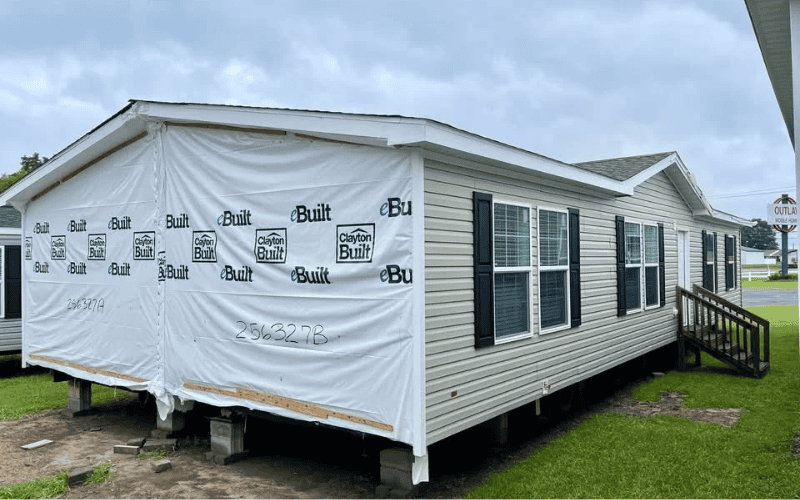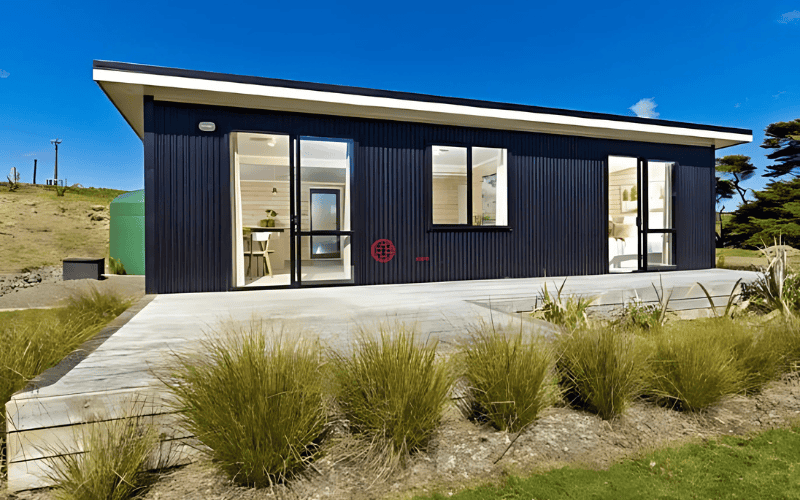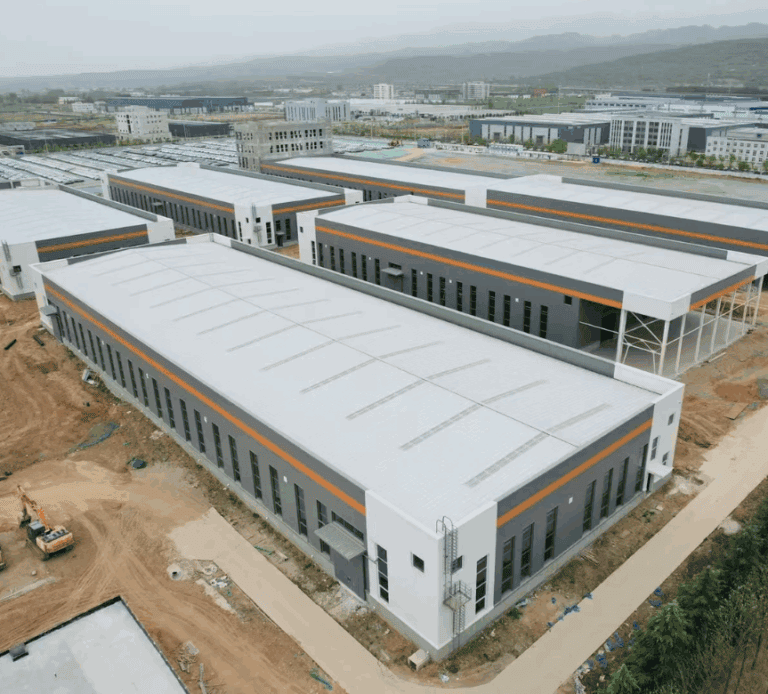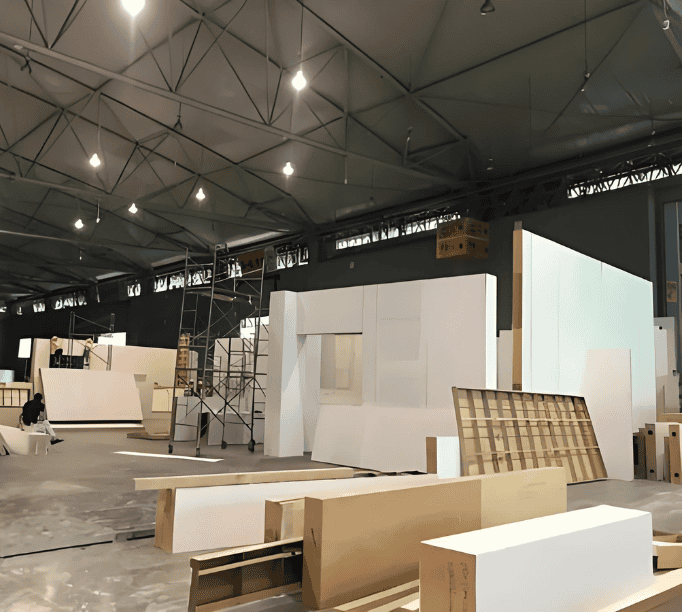Doppel- und Fertighäuser mögen auf den ersten Blick ähnlich aussehen, unterliegen aber ganz unterschiedlichen Bauvorschriften. Sie überlegen vielleicht, welche Option für Ihr Projekt besser geeignet ist.
Dieser Artikel erklärt alles im Detail. Wir definieren zunächst beide Haustypen und zeigen auf, wie sich ihre Bauvorschriften, ihre Struktur und ihre Lage unterscheiden. Anschließend erläutern wir fünf technische Aspekte – wie Vorschriften, Installation, Design und Finanzierung –, die sich direkt auf Ihr Budget und Ihren Zeitplan auswirken können.
Abschließend werfen wir einen Blick auf die Markttrends und darauf, warum immer mehr Bauherren jetzt Doppelhaushälften und modulare Lösungen kombinieren, um die Nase vorn zu behalten.
Unabhängig davon, ob Sie ein großes Bauprojekt planen oder einzelne Einheiten individuell anpassen, hilft Ihnen das Verständnis dieser grundlegenden Unterschiede dabei, intelligentere und schnellere Entscheidungen zu treffen.
Was sind Doppel- und Fertighäuser?
Doppelhäuser und Fertighäuser sind beliebte Alternativen zu herkömmlichen Fertighäusern, werden jedoch nach unterschiedlichen Standards gebaut und bedienen unterschiedliche Marktbedürfnisse. Das Verständnis dieser Haustypen ist für Bauherren, Bauträger und sogar Hauskäufer unerlässlich, um fundierte Entscheidungen treffen zu können.
Was ist ein Doppelhaus?
Ein Doppelhaus ist im Wesentlichen ein Fertighaus, das in zwei Teilen gebaut und am Aufstellungsort zusammengefügt wird. Diese Häuser unterliegen den Vorschriften der US-amerikanischen Bauordnung für Wohnungsbau und Stadtentwicklung (HUD).
Doppelbreite Häuser werden oft als Mobil- oder Fertighäuser bezeichnet und werden häufig in speziell für diese Art von Wohngebäuden konzipierten Wohnanlagen eingesetzt. Strukturell ruhen sie auf einem Stahlchassis, wodurch sie relativ leicht zu transportieren sind, allerdings können sie mit Einschränkungen durch die örtliche Baugenehmigung oder Finanzierung verbunden sein.
Was ist ein Fertighaus?
Modulhäuser hingegen werden in Modulen oder Abschnitten in einer Fabrik unter Einhaltung strenger staatlicher oder lokaler Bauvorschriften gebaut – dieselben Standards, die für traditionelle Häuser in Holzrahmenbauweise gelten.
Im Gegensatz zu Doppelhäusern werden Fertighäuser auf einem festen Fundament errichtet und sind nach der Fertigstellung kaum von herkömmlichen Häusern zu unterscheiden. Daher sind sie die bevorzugte Wahl für Bauträger, die langfristige Wohn- oder Gewerbelösungen suchen.
Einer der Hauptvorteile von Modulhäusern liegt in ihrer Gestaltungsflexibilität. Diese Häuser sind oft mehrgeschossig und ermöglichen vielfältige Anpassungen bei Grundrissen, Oberflächen und Fassaden. Ob Sie ein Vorstadthausprojekt entwickeln oder individuelle Eigenheime planen – der Modulbau bietet mehr Flexibilität in der architektonischen Gestaltung und Raumplanung.
Indem Sie bereits in diesem frühen Stadium zwischen Doppelhäusern und Fertighäusern unterscheiden, können Sie Ihre Baustrategie besser an die Leistungs-, Regulierungs- und Designanforderungen Ihres Projekts anpassen.

Hauptunterschiede zwischen Doppelhäusern und Fertighäusern
Bei der Bewertung von Doppel- und Fertighäusern ist es für Bauherren und Entwickler entscheidend, die technischen und regulatorischen Unterschiede zu verstehen, um fundierte Entscheidungen treffen zu können. Dieser Abschnitt beleuchtet die wichtigsten Unterschiede, die sich auf die Projektdurchführbarkeit und den langfristigen Investitionswert auswirken.
Strukturelle Standards und Code-Konformität
Doppelbreite Häuser werden nach den bundesstaatlichen Standards des Wohnungsbau- und Stadtentwicklungsministeriums (HUD) hergestellt, die in allen Bundesstaaten einheitlich gelten. Diese Vorschriften beziehen sich in erster Linie auf Fertighäuser und legen oft Wert auf Erschwinglichkeit und einfache Transportierbarkeit.
Umgekehrt müssen Fertighäuser, ähnlich wie traditionell vor Ort errichtete Häuser, den staatlichen und lokalen Bauvorschriften entsprechen. Das bedeutet, dass Fertighäuser oft eine höhere strukturelle Integrität und strengere Konformitätsanforderungen aufweisen und damit mit herkömmlichen Baupraktiken übereinstimmen.
Transport- und Installationsprozess
Double Wides werden in zwei Hälften mit jeweils integriertem Stahlchassis geliefert, was einen schnellen Transport und eine einfachere Einrichtung vor Ort ermöglicht. Sie werden normalerweise auf Pfeilern oder Blöcken platziert.
Modulhäuser werden jedoch in vollständig geschlossenen Modulen ohne festes Fahrgestell transportiert. Um die Module anzuheben und auf feste Fundamente zu setzen, sind Kräne erforderlich. Dies erhöht zwar die Komplexität, führt aber zu einer stabileren und langlebigeren Struktur.
Designflexibilität
Modulhäuser bieten vielfältige Möglichkeiten zur individuellen Gestaltung. Ihre Bauweise ermöglicht mehrstöckige Grundrisse, unregelmäßige Formen und maßgeschneiderte Grundrisse. Bauherren können hochwertige, energieeffiziente Designs entwickeln, die auf die Wünsche des Käufers zugeschnitten sind.
Bei Doublewides hingegen gelten standardisierte Grundrisse und Breiten (typischerweise 28–32 Fuß), was die Flexibilität insbesondere bei gehobenen oder städtischen Entwicklungsprojekten einschränkt.
Landnutzungsvorschriften und Finanzierung
Aus regulatorischer Sicht werden Fertighäuser in der Regel wie vor Ort gebaute Häuser betrachtet, was es einfacher macht, sie auf einer größeren Anzahl von Grundstücken zu platzieren und für herkömmliche Hypotheken von Banken in Frage zu kommen.
Doppelbreite Häuser, die als Fertighäuser eingestuft werden, unterliegen häufig baurechtlichen Beschränkungen und erfordern möglicherweise eine spezielle Finanzierung. Bauträger, die vereinfachte Genehmigungsverfahren und Finanzierungsmöglichkeiten suchen, sind mit Fertighäusern möglicherweise besser beraten.
Kosten für ein Doppelhaus im Vergleich zu einem Fertighaus
Vergleich der Erstkosten
- Doppelbreite Häuser sind im Allgemeinen wirtschaftlicher und kosten zwischen $50.000 und $100.000. Da der Bauprozess relativ einfach ist, sind die Kosten niedriger.
- Modulhäuser haben höhere Anschaffungskosten, in der Regel zwischen 70.000 und 150.000 TP4T, bieten aber Vorteile bei der Qualitätskontrolle und Materialauswahl. Modulhäuser verwenden hochwertigere Baumaterialien, um die Langlebigkeit und Stabilität des Hauses zu gewährleisten. Obwohl die Anfangsinvestition etwas höher ist, kann sich ein Modulhaus auf lange Sicht lohnen.
Langfristige Wartungskosten
- Modulhäuser bieten einen Vorteil hinsichtlich der Energieeffizienz. Dank der verbesserten Isolierung können sie im Winter effizienter heizen und im Sommer besser kühlen, was die Energiekosten senkt.
- Doppelhäuser sind zwar energieeffizienter, schneiden aber im Allgemeinen nicht so gut ab wie Fertighäuser, insbesondere bei älteren oder weniger teuren Doppelhäusern, was zu höheren Heiz- und Klimatisierungskosten führen kann.
Versand- und Installationskosten
- Der Transport von Doppelhäusern ist teurer, insbesondere bei großen Häusern oder abgelegenen Gebieten. Die Kosten können Tausende bis Zehntausende von Dollar betragen. Die Installation von Doppelhäusern ist komplex und kostet in der Regel $5.000 bis $15.000.
- Der Transport und die Installation von Fertighäusern sind effizienter, da die Versandkosten niedriger sind und die Installationskosten zwischen $3.000 und $10.000 liegen.
Insgesamt sind Fertighäuser zwar zunächst teurer, aber im Hinblick auf Energieeffizienz, langfristige Instandhaltung und versteckte Kosten bei der Installation kostengünstiger. Doppelhäuser sind zwar günstiger, können aber in Bezug auf langfristige Instandhaltung und Energieeffizienz kostengünstiger sein.
Bitte beachten Sie: Unabhängig davon, ob Sie sich für ein Doppel- oder Fertighaus entscheiden, müssen Sie die Kosten für die Grundstücksvorbereitung und die Infrastruktur berücksichtigen, einschließlich des Baus von Strom, Wasserversorgung und Abwasser sowie anderer Infrastruktur. Wenn diese Kosten nicht in den Kosten für den Hauskauf enthalten sind, erhöhen sie die Gesamtinvestition.
Anwendungsvergleich
Doppelbreite Häuser: Doppelhäuser eignen sich ideal für Familien oder Einzelpersonen, die viel Wohnraum suchen, aber nur über ein begrenztes Budget verfügen. Dank ihrer großzügigen Bauweise eignen sie sich besonders für ländliche oder vorstädtische Gebiete und bieten ausreichend Platz für Familien, Rentner oder Erstkäufer. Doppelhäuser sind einfach zu errichten und benötigen keine aufwendigen Fundamente. Dadurch sind sie eine schnelle und kostengünstige Wohnlösung.
Fertighäuser: Modulhäuser eignen sich für alle, die Wert auf hochwertige Bauweise und einen schnelleren Einzug legen und über ein höheres Budget verfügen. Sie werden häufig in städtischen, vorstädtischen oder mehrstöckigen Wohnprojekten eingesetzt. Modulhäuser bieten individuelle Anpassungsmöglichkeiten und sind ideal für Käufer, die Wert auf bessere Qualitätskontrolle, schnellere Bauzeit und flexible Gestaltung legen. Erstkäufer, Familien und Bauträger profitieren von Modulhäusern, insbesondere wenn hochwertige Bauweise und schnelle Bauzeiten entscheidend sind.
Das Verständnis dieser Unterschiede hilft Fachleuten dabei, die Produktauswahl an den Projektzielen auszurichten – sei es Geschwindigkeit, Anpassung, Standorteignung oder Investitionswert.

Welches Zuhause ist das richtige für Ihre Bedürfnisse?
Berücksichtigen Sie bei der Auswahl des richtigen Haustyps die folgenden Faktoren:
- Budget: Bei knappem Budget sind Doppelhäuser die günstigere Wahl, ideal für Käufer, die mehr Platz zu geringeren Kosten suchen. Modulhäuser sind zwar teurer, bieten aber eine höhere Qualität und langfristige Vorteile bei der Energieeffizienz.
- Lebensbedürfnisse: Wenn Sie höhere Qualität und mehr anpassbaren Raum benötigen, sind Fertighäuser die bessere Wahl. Sie bieten mehr Gestaltungsmöglichkeiten und eine höhere Langlebigkeit und eignen sich für Käufer, die Wert auf Details und langfristiges Wohnen legen.
- Bauzeit: Wenn Sie schnell einziehen müssen, sind Fertighäuser in der Regel schneller fertig und bezugsfertig. Doppelbreite Häuser sind zwar schneller, aber Transport- und Installationskomplexitäten können zu Verzögerungen führen.
| Besonderheit | Doppelbreite Häuser | Fertighäuser |
| Budget | Wirtschaftlich, ideal für preisbewusste Käufer | Höhere Anschaffungskosten, aber langfristig besserer Wert |
| Lebensbedürfnisse | Geräumig, geeignet für Familien | Anpassbares Design und hochwertigere Struktur |
| Bauzeit | Schneller Aufbau, kann sich aber durch Transport und Installation verzögern | Vorfertigung beschleunigt den Bau und ermöglicht einen schnelleren Einzug |
| Energieeffizienz und Wartung | Geringere Effizienz, höhere langfristige Energiekosten | Bessere Energieeffizienz und langfristige Einsparungen |
Markttrends: Chancen im Fertighausbau
Die Fertighausbranche, einschließlich Modul- und Doppelhäusern, hat in den letzten Jahren ein deutliches Wachstum verzeichnet, mit einem weltweiten zweistelligen jährlichen Wachstum. Dieser Trend weckt die Aufmerksamkeit von Bauherren und Bauträgern.
Ein wichtiger Treiber ist die steigende Nachfrage nach kostengünstigem, energieeffizientem Wohnraum. Modul- und Doppelhäuser eignen sich ideal für nachhaltige Bauprojekte, da ihre werkseitig kontrollierte Bauweise Abfall reduziert und energiesparende Funktionen wie Solarmodule, moderne Isolierung und intelligente HLK-Systeme ermöglicht.
Auch die Unterscheidung zwischen Fertighäusern und Doppelhäusern wird immer unschärfer. Bauträger kombinieren beide Lösungen, um die Flexibilität zu erhöhen. Doppelhäuser werden beispielsweise in Vororten eingesetzt, während Fertighäuser für städtische oder mehrstöckige Projekte geeignet sind. Dieser hybride Ansatz ermöglicht es Bauträgern, schneller zu skalieren und mehrere Marktsegmente zu erreichen.
Für Immobilienentwickler bieten diese Trends wertvolle Chancen. Der Einsatz vorgefertigter Lösungen kann die Baukosten senken, die Markteinführungszeit verkürzen und moderne, gefragte Funktionen bieten. Modul- und Doppelhäuser verändern das moderne Bauen.
Wenn Sie diese Optionen verstehen, können Sie die beste Lösung für Ihre Projekte auswählen und sie schneller, flexibler und profitabler gestalten.
Jetzt ist es an der Zeit, intelligenter zu bauen – mit Fertighäusern. Entdecken Sie unsere Doppelbreite Fertighäuser heute, um immer einen Schritt voraus zu sein!

